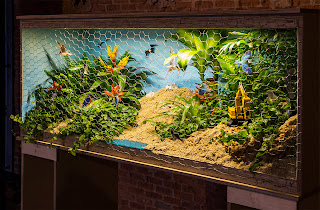The Amazing History of the Republic of Nauru
Jorge Mañes new social design project about the island of Nauru reveals one of the saddest and most unbelievable recent histories of what could and should be paradise.
This time Mañes has taken his very social approach to design to tackle the fascinating - albeit devastating - history of the little-heard-of island in the South Pacific, Nauru.
The project is organized by DIMAD, Madrid’s design association and is being held at the Matadero Cultural Centre.
“They asked me to do something about travelling and I immediately thought about Nauru,” Mañes says. “It is an amazing story and hardly anybody has even heard about it.”
The result is part fact, part fiction, which reflects the disbelieving reactions Mañes received when trying to share the island’s facts with his family and friends. “Nobody even believed me,” he says. “They didn’t think it could possibly be true. So I have used facts and fantasy to try to encourage people to dig further and find out for themselves just what happened there.”
Nauru was once upon a time a true paradise with less than 1000 inhabitants who mostly fished to survive. In the late 19th century the Germans colonized the place. After World War I it became a League of Nations mandate administered by Australia, New Zealand and the United Kingdom. The Japanese occupied the island during WWII and then the Americans bombed it.
In 1968 Nauru finally gained its independence and became a Republic. Thanks to its rich phosphate deposits it was by then the (per capita) richest country in the world. Phosphates come from bird droppings and birds had always migrated to the island in vast numbers.
“It was great that the people of Nauru were able to start running their own country and controlling their own resources,” Mañes says, “but the mining was already underway and soon corruption, bad investment decisions and no environmental vision joined forces to create the island’s fate.”
Eventually all the natural resources were depleted and the population of 9 000 was left destitute and bankrupt.
“It is extraordinary,” Mañes says. “They went from so rich to so poor very quickly. The lesson learned is just how important sustainability really is.”
In the exhibition, Mañes presents a diorama, a book and a flag that each play with the viewer’s perception. They flit from seeing the island as a utopia to a disaster area until its fictitious future imagines a once-again paradise overtaken by birds that even have their own flag. Given a second chance the island is run in a less ambitious, more sustainable way.
Below is a letter written by a former president of Nauru, Marcus Stephen. It was published in the New York Times.
Nauru, 18 July 2011
I forgive you if you have never heard of my country.
At just 8 square miles, about a third of the size of Manhattan, and located in the southern Pacific Ocean, Nauru appears as merely a pinpoint on most maps — if it is not missing entirely in a vast expanse of blue.
But make no mistake; we are a sovereign nation, with our own language, customs and history dating back 3,000 years. Nauru is worth a quick Internet search, I assure you, for not only will you discover a fascinating country that is often overlooked, you will find an indispensible cautionary tale about life in a place with hard ecological limits.
Phosphate mining, first by foreign companies and later our own, cleared the lush tropical rainforest that once covered our island’s interior, scarring the land and leaving only a thin strip of coastline for us to live on. The legacy of exploitation left us with few economic alternatives and one of the highest unemployment rates in the world, and led previous governments to make unwise investments that ultimately squandered our country’s savings.
I forgive you if you have never heard of Nauru but you will not forgive yourselves if you ignore our story.









(Flag design together with Gianluca Tesauro)
www.seethisway.com
http://www.seethisway.com/seethisway/Nauru.html








 (Flag design together with Gianluca Tesauro)
www.seethisway.com
http://www.seethisway.com/seethisway/Nauru.html
(Flag design together with Gianluca Tesauro)
www.seethisway.com
http://www.seethisway.com/seethisway/Nauru.html








 (Flag design together with Gianluca Tesauro)
www.seethisway.com
http://www.seethisway.com/seethisway/Nauru.html
(Flag design together with Gianluca Tesauro)
www.seethisway.com
http://www.seethisway.com/seethisway/Nauru.html
